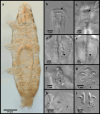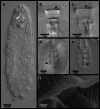Three new species of Mesobiotus (Eutardigrada: Macrobiotidae) from Sweden with an updated phylogeny of the genus
- PMID: 39915525
- PMCID: PMC11802830
- DOI: 10.1038/s41598-025-88063-8
Three new species of Mesobiotus (Eutardigrada: Macrobiotidae) from Sweden with an updated phylogeny of the genus
Abstract
Three new species of Mesobiotus (Tardigrada: Eutardigrada: Macrobiotidae) are described from Skåne County in the southernmost region of Sweden. All three species are distinguished morphologically and through differences in DNA sequences as supported by PTP and mPTP analyses. With the addition of Mesobiotus bockebodicus sp. nov., M. skanensis sp. nov., and M. zelmae sp. nov., the number of nominal species of Macrobiotidae in Sweden has increased to 26, 73% of which have been documented from Skåne. Finally, new morphological details and DNA sequences are presented for Mesobiotus emiliae, a new record is presented of M. mandalori from Sweden, and the phylogenetic relationships within the genus is reconstructed using previously published and new 18S and COI gene sequences.
Keywords: Diversity; Macrobiotidae; New species; Phylogeny; Tardigrades; Taxonomy.
© 2025. The Author(s).
Conflict of interest statement
Declarations. Competing interests: The authors declare no competing interests.
Figures














References
-
- Guidetti, R., Rizzo, A., Altiero, T. & Rebecchi, L. What can we learn from the toughest animals of the Earth? Water bears (tardigrades) as multicellular model organisms in order to perform scientific preparations for lunar exploration. Planet. Space Sci.74, 97–102. 10.1016/j.pss.2012.05.021 (2012).
-
- Bartylak, T. et al. Terrestrial Tardigrada (Water Bears) of the Słowiński National Park (Northern Poland). Diversity16, 239. 10.3390/d16040239 (2024).
-
- Dueñas-Cedillo, A. et al. Towards an inventory of Mexican tardigrades (Tardigrada): a survey on the diversity of moss tardigrades with an emphasis in conifer forests from the Valley of Mexico Basin. Check List.20, 471–498. 10.15560/20.2.471 (2024).
MeSH terms
LinkOut - more resources
Full Text Sources

